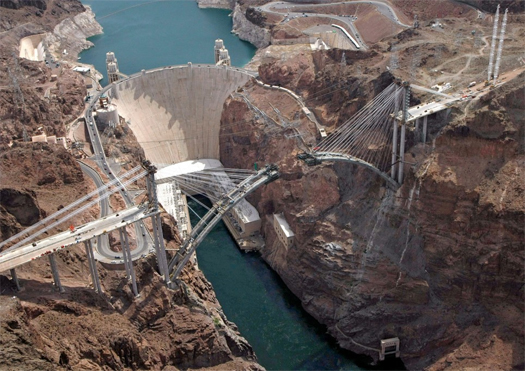
[Aerial image of the Hoover Dam Bypass under construction; I’d love to give credit for the image to the photographer, but it came to me through a long email chain, lacking any attribution, and I haven’t been able to locate the source]
Economics journalist Louis Uchitelle complains about a “superproject void” in the Times; Infrastructurist responds, arguing that California’s high speed rail, the nation-wide revival of streetcar networks, and the “smart grid” could all be considered “superprojects”. As commentators point out, he’s also ignoring relatively traditional but underground projects such as Chicago’s Deep Tunnel, the ARC Tunnel, and the third New York water tunnel, and important new-but-distributed infrastructures (the “smart grid”, the replacement of radar by GPS-based flight control). And Infrastructurist is also right to make the Varnelis-esque point that “we’re a heavily populated wealthy democracy with a dysfunctional political culture that favors paralysis over action,” though it’s a point that runs counter (as Infrastructurist states) to the overall theme of the post.
That said, Infrastructurist doesn’t really respond to Uchitelle’s points about the relationship between scale and economic effect, as Uchitelle is arguing not just that that contemporary infrastructure projects are smaller, but that there’s something fundamentally different about the economic effect of a very large project, like the ARC Tunnel, which, while physically impressive, operates in a relatively small geographic territory, and a superproject, which connects formerly disconnected territories (as the interstate highway system did), aggregating markets. The obvious contemporary corollary to the interstate is high speed rail, but Uchitelle also rightly notes that the Obama administration project which is closest to a superproject, defined not just by impressive physical impact, but also by economic effect and ability to facilitate new connections, is the proposed integrated health care computer network.


be-autiful shot of the hoover dam.
for me the projects should have been evaluated in two ways: “network/single-entity projects” and “scale”. Scale is obvious (the 2nd ave subway is a connector within NYC but only affects the city directly, not larger entities) and simply further separates projects according to the first categorization.
I think you pick up on this well, whereas the Times guy doesn’t draw this distinction (his first paragraph is an indiscriminate mix of both). One of the infrastructurist’s commenters picked up on the possible differences in “super-” and “mega-” projects. Perhaps Uchitelle is suggesting that superprojects are defined by noticible economic impact, especially over a long time frame (his article obviously frames the projects economically) whereas megaprojects are more defined by scale, and may have a focus of environmental, social, political, and economic effects in any order.
of course, I’m not sure about this. To some degree, for me, he’s just voicing sentiment (we used to be great! we used to build big things! we never build big things any more! Maybe we’re not great…).
in theory I am a proponent of what i would call “network projects” as they would tend to be defined by flexibility and resilience and am against “single intervention/entity” projects of the mega variety as they are defined by robustness and bigness.
I think you’re right that Uchitelle (at least the way he presents himself in this article) flitters back and forth between infrastructural nostalgia and the genuinely useful point that degree of dispersal and connectivity is a vital measure for determining the economic value of a large infrastructural project. But there’s currently a whole lot of nostalgia for vast infrastructures, so I didn’t think that particularly interesting.
Whether Uchitelle is clear about the distinction between the former and the latter or not, the latter remains an important point.
[…] as faslanyc noted in the comments on a previous post, the impact of an infrastructure on the territory in which it resides should be […]
[…] as faslanyc noted in the comments on a previous post, the impact of an infrastructure on the territory in which it resides should be […]
[…] Permalink – Not a super project void. […]
[…] through the coming decade) is perhaps the best example of the continued relevance of the infrastructural “superproject” to emerge in the past decade. Nonetheless, we debated whether or not it belonged on this list […]
[…] through the coming decade) is perhaps the best example of the continued relevance of the infrastructural “superproject” to emerge in the past decade. Nonetheless, we debated whether or not it belonged on this list […]